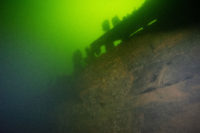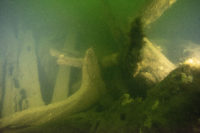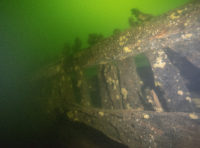 Two wrecks of 17th century warships, one of them believed to be the sister ship of King Gustav II Adolf’s flagship Vasa which famously sank less than a mile from the dock on its maiden voyage on August 10th, 1628, have been discovered in the Swedish archipelago in a strait outside the town of Vaxholm.
Two wrecks of 17th century warships, one of them believed to be the sister ship of King Gustav II Adolf’s flagship Vasa which famously sank less than a mile from the dock on its maiden voyage on August 10th, 1628, have been discovered in the Swedish archipelago in a strait outside the town of Vaxholm.
“When I came down as the first diver… I saw this wall 5-6 metres high and I came up and there was a massive warship,” diver and maritime archaeologist Jim Hansson told AFP, adding that “it was a thrilling feeling”.
 The wrecks are in good condition, preserved in the cold, brackish waters of Lake Mälaren. Not the kind of condition the Vasa is in, salvaged from Stockholm bay in 1961, but that’s to be expected because unlike their ill-fated cousin, these ships actually served in Sweden’s navy, fought battles, and were deliberately scuttled at the end of their topside lifespan to serve in their watery graves as defensive spike strips to damage any enemy ships seeking to attack Stockholm through the straight.
The wrecks are in good condition, preserved in the cold, brackish waters of Lake Mälaren. Not the kind of condition the Vasa is in, salvaged from Stockholm bay in 1961, but that’s to be expected because unlike their ill-fated cousin, these ships actually served in Sweden’s navy, fought battles, and were deliberately scuttled at the end of their topside lifespan to serve in their watery graves as defensive spike strips to damage any enemy ships seeking to attack Stockholm through the straight.
 Henrik Hybertsson, the Dutch master shipwright who made the Vasa at the Stockholm navy yard, was commissioned to build four ships in total, two larger ones with 135-foot keels (Vasa and Äpplet) and two smaller ones (Kronan and Scepter) with 108-foot keels. Archaeologists think one of the two newly-discovered wrecks may be Äpplet as it appears to match Vasa in design and size. It was laid down in 1627 and launched in 1629.
Henrik Hybertsson, the Dutch master shipwright who made the Vasa at the Stockholm navy yard, was commissioned to build four ships in total, two larger ones with 135-foot keels (Vasa and Äpplet) and two smaller ones (Kronan and Scepter) with 108-foot keels. Archaeologists think one of the two newly-discovered wrecks may be Äpplet as it appears to match Vasa in design and size. It was laid down in 1627 and launched in 1629.
The divers took wood samples of the ships which will be sent to a laboratory for dating.
“Then we can even see where the timber has been cut down and then we can go back and look in the archives and I think we have good chances to tell exactly which ship this is,” Hansson said.